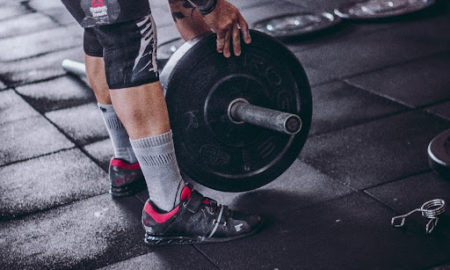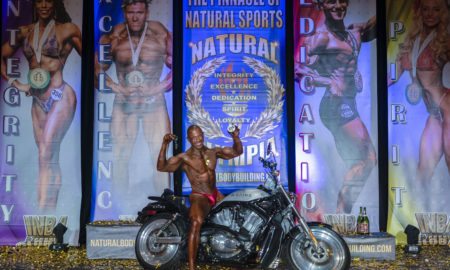In Part 1 we examined the way resveratrol works in the body, in particular its protective properties against cardiovascular disease and cancer. This time we’re taking a look at its antiaging properties and why bodybuilders need to take note of it.
Antiaging Effects
The only technique known to maximize life span in animals—not yet proven in humans—is calorie restriction. The method usually involves lowering the daily calorie intake by 30 to 40 percent, which is said to lessen oxidative effects. Some scientists, however, think that calorie restriction works because it activates a protective enzyme called SIRT1, which removes acetyl groups from specific proteins, triggering what’s called a gene-silencing effect—that is, it inhibits the activity of certain genes in the body.
Among those genes are the ones that control the aging process. Studies show that, like calorie restriction, resveratrol is capable of increasing the activity of SIRT1 as much as 13-fold over baseline. That implies that much of the aging-related benefit of calorie restriction may be obtainable with resveratrol. That also explains the attraction of resveratrol to life-extension devotees. Some studies show that it extends the longevity of yeast—by 70 percent—worms and fish. Others, however, have shown no life extension in yeast and worms.
The first study that pointed to a life-extension effect of resveratrol in mammals used mice.7 Middle-aged mice were put on a diet that contained 60 percent fat. Another group of mice got a standard diet. Those in the high-calorie group were also given resveratrol at a dose of 22.4 milligrams per kilogram of bodyweight daily. Another group of mice ate the high-fat diet but didn’t get resveratrol. While both high-fat groups became obese, those on the resveratrol lived as long as control animals. The resveratrol mice also had enhanced insulin sensitivity, along with an increased number of mitochondria in their livers that matched that of the calorie-restricted mice.
A diet that derives 60 percent of its calories from fat isn’t normal, so another study featured mice that ate a standard diet supplemented with resveratrol. In that case, resveratrol didn’t provide any life-extending effects.8 It did, however, prevent age-related cardiovascular and obesity-related functional decline in the mice. After 10 months of resveratrol treatment, cholesterol levels declined in the mice, and the aortas functioned better in resveratrol-treated mice than in the ones that didn’t get the compound. Resveratrol also reduced heart inflammation as well as several other beneficial effects:
• Increased bone health, including density, volume, mineral content and bending stiffness
• Reduced cataract formation in older mice
• Enhanced balance and coordination
• A mimicking of the effects of calorie restriction in the gene expression profiles of liver, skeletal muscle and fat tissue
Evidence shows that resveratrol and SIRT1 activation can help with several diseases linked to aging, such as type 2 diabetes, cardiovascular disease, brain degeneration and inflammation.
Resveratol and Bodybuilding
Resveratrol may be relevant to weight training on several counts. One effect of restricting calories is that muscle ages far more slowly than it otherwise would. Loss of muscle function declines in animals that are on restricted calories—although it’s worth noting that humans who follow that kind of low-calorie regimen appear emaciated and atrophied. Mouse studies show that resveratrol duplicates favorable gene processes in muscles that take place with calorie restriction. The potent antioxidant activity of resveratrol may also contribute to that. While it remains to be demonstrated in humans, it’s plausible that taking resveratrol helps slow muscle aging. Indeed, scientists now recognize that a major cause of muscle aging is a gradual accumulation of iron in muscle over the years. That causes oxidation of muscle RNA, leading to damage and loss of muscle function.9 Resveratrol chelates excess iron, thus preventing the iron-related oxidative damage.
Even so, when taken in excessive amounts, resveratrol itself can turn into a pro-oxidant, leading to free iron release and its attendant oxidative damage. Keep in mind that in natural sources, such as red wine, resveratrol is present in small doses and is accompanied by other natural antioxidants, such as the flavonoids and polyphenols that keep it stable. All antioxidants work as a team.
Resveratrol also favorably affects testosterone counts. Although it can interact with estrogen receptors, in low doses it competes with estrogen for interaction with the receptors, an effect similar to the drug Nolvadex. Resveratrol also inhibits the enzyme aromatase, which converts androgens such as testosterone into estrogen. A recent study with rabbits showed that resveratrol increased erections (likely due to its NO-boosting effect) and testicular sperm counts and boosted blood testosterone by 51.6 percent.10 Another study found that resveratrol protected against testicular injury caused by environmental toxins in rats.11
A recent isolated-cell study found that resveratrol helped maintain muscle mass by increasing the proliferation of satellite cells, which are required to repair damaged muscle cells. Satellite cell activity commonly decreases with age, and it’s considered a major cause of muscle frailty in the elderly. The favorable effect of resveratrol in the study was related to increased SIRT1 activity.12
In another study mice that had been specially bred to age rapidly were given resveratrol and exercise.13 Other mice exercised but didn’t get resveratrol. Those not getting the resveratrol showed a decreased endurance capacity over 12 weeks, while those getting 0.2 percent resveratrol along with exercise maintained their endurance. The mice in the resveratrol group experienced a significant increase in oxygen consumption and mitochondrial energy enzymes. The study suggests that when combined with exercise, resveratrol may improve and maintain mitochondrial function in muscle. That’s highly significant, since loss of mitochondria in muscle is a major cause of muscle loss with aging.
In a study published two years ago, young mice given high-dose resveratrol—400 milligrams per kilogram of bodyweight—showed resistance to obesity, as well as increased aerobic-exercise capacity and less muscle fatigue during exercise. The mice were able to run twice as far before exhaustion set in.14
Cell studies show that resveratrol inhibits the development of fat cells.15,16 Another study found that it inhibits insulin secretion and increases insulin sensitivity.17 High insulin counts stimulate increased bodyfat synthesis, especially when accompanied by excess calorie or carbohydrate intake. The study showed that resveratrol blocks the inhibitory effects of insulin on epinephrine-stimulated fat oxidation.
One problem with the popular supplement conjugated linoleic acid is that it brings on inflammation and insulin resistance in fat cells. Those side effects, however, are completely blocked by resveratrol, according to a recent study.18
Various companies are working on developing drugs that spur SIRT1 activity. That could have enormous effects in antiaging medicine. One drug activated SIRT1 four times more than resveratrol, suggesting that lower doses may be used in comparison to resveratrol. In another recent study the experimental drug SIRT1720 proved to be a thousand times more potent than resveratrol in activating SIRT1. Mice given it had twice the endurance of untreated mice, and the drug prevented diet-induced bodyfat accretion by increasing fat oxidation in the rodents’ skeletal muscles, liver and brown adipose tissue.
On the other hand, it may be premature to take huge doses of resveratrol. A recent study of isolated mice neurons showed that large amounts of SIRT1 led to damage of brain cells through heightened oxidative activity. That implies that overstimulation of SIRT1 enzymes could have a paradoxical reverse effect—damaging health. Another study found that resveratrol protects the heart under conditions of ischemia, or blockage of blood flow to the heart, as occurs during a typical heart attack.20 Higher doses had an opposite effect, initiating a death signal in heart cells.
In practical terms, this suggests that those who take huge doses of resveratrol may succumb to a heart attack that they might have survived had they been taking low doses of resveratrol. The mechanism was thought to be due to the accumulation of free iron.
Several other studies point to potentially serious health problems for people who take huge doses of resveratrol. For example, an animal study found that while resveratrol hindered tumor growth, it also blunted wound healing.21 An isolated-cell study found that high-dose resveratrol inhibited the synthesis of vital cellular nucleic acid compounds, such as RNA and DNA, and thus adversely affected protein synthesis, resulting in cellular death.22 In a 28-day study of high-dose resveratrol, treated rats showed signs of kidney toxicity, dehydration, anemia and abnormal liver function.23
If you choose to supplement with resveratrol, make sure that the supplement contains trans-resveratrol, the active form. Also carefully examine the elemental, or actual, levels of trans-resveratrol listed on the label, since many companies attempt to confuse consumers by listing only the amount of the resveratrol source, such as Japanese knotwood, or the total resveratrol content, including the inactive Cis form. The optimal human dose is unknown, despite what you may read on the Internet.
Beware of obtaining resveratrol from fly-by-night Internet suppliers. You have no assurance of quality control related to purity and potency and will be paying premium prices. Although resveratrol is fat-soluble, it does not have to be consumed with a meal containing fat, as do such fat-soluble nutrients as vitamins A, E, D and K.
Another alternative is to have a glass of red wine, sit back and watch what happens to those who force megadoses of resveratrol down their throats. It won’t take another study to see who is happier.
References
7 Baur, J.A., et al. (2006). Resveratrol improves health and survival of mice on a high-calorie diet. Nature. 444:337-42.
8 Pearson, K.J., et al. (2008). Resveratrol delays age-related deterioration and mimics transcriptional aspects of dietary restriction without extending lifespan. Cell Metabol. 8:157-68.
9 Xiu, J., et al. (2008). Iron accumulation with age, oxidative stress and functional decline. Plos One.E2865.
10 Shin, S., et al. (2008). Trans-resveratrol relaxes the corpus cavernosum ex vivo and enhances testosterone levels and sperm quality in vivo. Arch Pharm Res. 31:83-87.
11 Jiang, Y.G., et al. (2008). Resveratrol reestablishes spermatogenesis after testicular injury in rats caused by 2,5-hexanedione. Chin Med J. 121:1204-1209.
12 Rathbone, C.R., et al. (2008). SIRT1 increases skeletal muscle precursor cell proliferation. Eur J Cell Biol. 88(1):35-44.
13 Murase, T., et al. (2008). Suppression of the aging-associated decline in physical performance by a combination of resveratrol intake and habitual exercise in senescence-accelerated mice. Biogerontol. In press.
14 Lagouge, M., et al. (2006). Resveratrol improves mitochondrial function and protects against metabolic disease by activating SIRT1 and PGC1-alpha. Cell. 127:1109-22.
15 Fischer-Posovszky, P., et al. (2008). SIRT1 is involved in resveratrol-stimulated changes in human adipocytes. Int J Obes. 32(supp1):S44.
16 Rayalam, S., et al. (2008). Resveratrol induces and inhibits adipogenesis in 3T3-L1 adipocytes.Phytother Res. 22:1367-1371.
17 Szkudelska, K., et al. (2008). Is resveratrol a dietary compound which helps to prevent obesity? Int J Obes. 32(supp1):S37.
18 Kennedy, A., et al. (2008). Conjugated linoleic acid-mediated inflammation and insulin resistance in human adipocytes are attenuated by resveratrol. J Lipid Res. In press.
19 Deige, J.N., et al. (2008). Specific SIRT1 activation mimics low energy levels and protects against diet-induced metabolic disorders by enhancing fat oxidation. Cell Metabol. 8:347-358.
20 Dudley, J., et al. (2008). Resveratrol, a unique phytoalexin present in red wine, delivers either survival signal or death signal to the ischemic myocardium depending on dose. J Nutr Biochem. 20(6):443-452.
21 Brakenheilm, E., et al. (2001). Suppression of angiogenesis, tumor growth and wound healing by resveratrol, a natural compound in red wine and grapes. FASEB J. 15:1798-1800.
22 Dubash, B.D., et al. (2000). Inhibitory effect of resveratrol and related compounds on the macromolecular synthesis in HL-60 cells and the metabolism of 7,12-dimethylbenz(a)anthracene by mouse liver microsomes. In F. Shahidi and C.T. Ho (Eds.), Phytochemicals and Pharmaceuticals. Champaign, IL: AOCS Press.
23 Crowell, J.A., et al. (2004). Resveratrol-associated renal toxicity.Toxicol Sci. 82:614-19. IM
















You must be logged in to post a comment Login